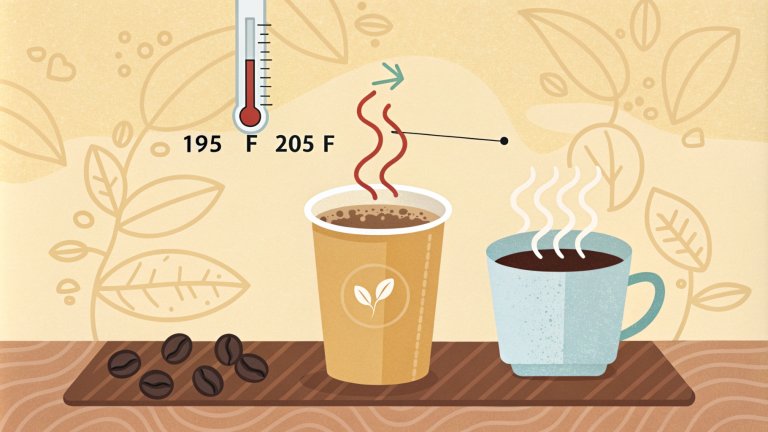
That first sip of morning coffee should energize your day, not leave you wondering why your coffee tastes burnt. The harsh, bitter flavor that hits your palate can ruin your coffee experience. Most coffee drinkers face this frustrating problem at some point, but the good news is that burnt-tasting coffee is entirely preventable. Once you understand the root causes, you can take control and enjoy a perfect cup every time, reassuring you that your coffee experience can be consistently enjoyable.
Your burnt coffee problem likely stems from one of several common issues that affect extraction and flavor development. However, the solution is often more straightforward than you think, requiring just a few adjustments to your brewing routine. As a coffee enthusiast, this simplicity should empower you to take control of your brewing process and instill confidence in your ability to enjoy a perfect cup every time.
What Makes Coffee Taste Burnt
Coffee develops that unpleasant burnt flavor through specific chemical processes during roasting or brewing. When coffee beans are exposed to excessive heat for too long, compounds like guaiacol form, creating harsh, smoky notes that overpower your cup, bitter compounds can also develop during brewing if your water temperature exceeds the optimal range.
The illustration depicting a thermometer and a steaming coffee cup poses the question about the correct water temperature for brewing.
The science behind why coffee tastes burnt involves understanding extraction principles. Water pulls different compounds from coffee grounds at different rates and temperatures. Acids and sugars extract quickly, while bitter compounds need more time and heat. When brewing conditions push extraction beyond the sweet spot, you get an unbalanced cup dominated by harsh flavors.
Top Causes Why Does Coffee Taste Burnt
Over-Roasted Coffee Beans
The most common reason coffee tastes burnt starts with the beans themselves. Over-roasted beans appear very dark, almost black, with an oily, shiny surface that indicates the oils have been forced to the surface. When roasters push beans beyond the optimal roasting point, natural sugars caramelize excessively, creating charcoal-like flavors.
Dark roast coffee is more likely to have burnt flavors than medium or light roasts. While some coffee lovers enjoy bold, smoky characteristics, there’s a fine line between rich flavor and burnt taste. Quality dark roasts should taste robust without being harsh or bitter.
Water Temperature Problems
Water temperature is the second most critical factor in why coffee tastes burnt. Most home coffee makers heat water to a boiling point, which exceeds the optimal extraction temperature of 195-205°F. When water temperature climbs above this range, it scalds the coffee grounds. Therefore, controlling the water temperature is crucial in preventing a burnt taste in your brewed coffee.
A coffee thermometer shows water temperature, which is crucial for avoiding
a burnt taste in brewed coffee.
Different roast levels require slightly different brewing temperatures. Dark roasts should be brewed at the lower end of the range, 185-195°F to prevent over-extraction. Light roasts can handle higher temperatures up to 205°F without developing burnt flavors.
Grind Size and Over-Extraction
Incorrect grind size is a leading cause of coffee’s burnt taste, especially with espresso brewing. Over-extraction happens when water contacts coffee grounds for too long or the grind size is too fine. This creates coffee that appears very dark, drips slowly, and produces small volumes even after extended brewing.
An infographic illustrating different coffee grind sizes from coarse to fine, with visual examples and recommended brewing methods for each grind type.
The telltale signs of over-extraction include extremely bitter flavors that linger on your palate and a soggy, compact coffee puck in espresso machines. Different brewing methods require specific grind sizes to achieve proper extraction. French press needs coarse grounds while espresso requires fine particles.
Equipment Maintenance Issues
Dirty coffee equipment represents another primary reason coffee tastes burnt. Coffee residue and oils build up inside machines over time, creating rancid flavors that contaminate fresh brews. Warming plates on drip coffee makers continue “cooking” coffee after brewing, breaking down oils and creating burnt flavors.
A complete cleaning kit for coffee and espresso machines, including specialized detergent, brushes, and microfiber cloths.
Even coffee grinders contribute to burnt taste if their burrs generate excessive heat during grinding. Blade grinders spinning at high speeds heat beans before they reach your brewing device. Regular cleaning prevents most equipment-related burnt flavors.
How to Fix Coffee That Tastes Burnt Right Now
Quick Brewing Method Adjustments
When you’re stuck with burnt-tasting coffee and need an immediate solution, start with your grind size. Make your grind slightly coarser to reduce extraction time and prevent over-extraction. Lower your water temperature by 5-10 degrees from whatever you use.
Shorten your brewing time using methods like French press or pour-over. These simple adjustments can often salvage a potentially burnt-tasting brew. The key is changing one variable at a time to identify what’s causing the problem.
Emergency Salvage Techniques
If your already-brewed coffee tastes burnt, try adding a tiny pinch of salt to neutralize some bitterness. This won’t completely fix the problem, but it can make the coffee more drinkable. Cold brewing over-roasted beans often produces smoother results than hot brewing methods.
Some burnt coffee simply can’t be salvaged. If your beans are heavily over-roasted or your equipment consistently produces burnt flavors, no amount of technique adjustment will help. Over-roasted beans cannot be “fixed” since the chemical changes that create burnt flavors are permanent.
Preventing Burnt Coffee Taste Long-Term
Choosing Quality Beans and Storage
Prevention offers the best approach to avoiding why coffee tastes burnt. Choose medium-roasted beans instead of dark roast beans to reduce the risk of a burnt flavor. Buy from reputable roasters who provide precise roast dates and avoid beans with excessively oily, shiny surfaces. Also, properly storing your coffee beans in airtight containers away from light, heat, and moisture is crucial in maintaining their quality and preventing a burnt taste.
Store coffee beans in airtight containers away from light, heat, and moisture. Room-temperature storage works best; avoid refrigerators or freezers, which can damage beans. To maintain freshness, buy only what you’ll consume within a month.
Equipment Maintenance Schedule
Clean your coffee equipment regularly to prevent residue buildup that causes burnt flavors. Daily cleaning should include rinsing removable parts, while weekly deep cleaning prevents oil buildup. Descalve your machine every few months, depending on water hardness.
Caffenu cleaning and descaling products showcased with a single-serve coffee machine, highlighting the importance of equipment maintenance for better coffee taste.
Replace worn parts like grinder burrs when they become dull, as they can generate excessive heat. Keep your equipment in top condition to ensure consistent, non-burnt coffee flavors. A proper maintenance schedule prevents most burnt coffee problems.
Best Brewing Methods to Avoid a Burnt Taste
Cold Brew for Over-Roasted Beans
Cold brew offers an excellent solution for wondering why coffee tastes burnt with certain beans. The cold extraction process pulls fewer bitter compounds from coffee grounds, making it ideal for darker roasts. Steep coarsely ground coffee in cold water for 12-24 hours for smooth, less acidic results.
Precise pour-over coffee brewing, where water temperature prevents a burnt taste.
This method works exceptionally well for over-roasted beans that might taste burnt when brewed hot. The extended steeping time allows for complete flavor extraction without the harsh compounds that hot water creates. Cold brew produces concentrated coffee that you can dilute to taste.
French Press and Pour-Over Techniques
French press brewing gives you complete control over water temperature and steeping time. The immersion method extracts coffee oils for rich flavor without the harsh bitterness of over-extraction. Pour-over methods like V60 allow precise temperature control and highlight coffee’s natural flavors.
These manual methods help prevent coffee from tasting burnt by giving you direct control over all brewing variables. You can adjust water temperature, grind size, and timing based on your specific beans and preferences. Manual brewing methods generally produce less burnt-tasting coffee than automatic machines.
Expert Tips From Professional Baristas
Understanding the relationship between different causes and their risk levels helps you prioritize your troubleshooting efforts. Over-roasted beans and water temperature represent the highest risk factors for burnt coffee. Equipment issues and extraction problems fall into medium-risk categories.
Risk levels of different causes that lead to a burnt coffee taste
This systematic approach to identifying why coffee tastes burnt saves time and frustration. Start with the highest risk factors, then work your way down the list. Most burnt coffee problems stem from just one or two common causes.
Brewing Method Comparison for Perfect Coffee
Different brewing methods carry varying levels of burnt taste risk. Cold brew and French press offer the lowest risk of producing burnt-flavored coffee. Espresso and Moka pot brewing require more skill to avoid burnt flavors due to their high pressure and temperature requirements.
Beginners should start with low-risk brewing methods like French press or pour-over to avoid wondering why coffee tastes burnt. These methods are more forgiving of minor mistakes in temperature or timing. As your skills develop, you can explore higher-risk methods like espresso brewing.
Frequently Asked Questions About Burnt Coffee
Can You Fix Already Brewed Burnt Coffee?
Once coffee is brewed and tastes burnt, your options are limited. Adding a pinch of salt can help neutralize some bitterness, but heavily burnt coffee is best discarded. Prevention through proper technique works much better than fixing burnt coffee after brewing.
Does Dark Roast Always Taste Burnt?
Quality dark roast should not taste burnt. The difference lies in roasting skill and bean quality. Professional roasters can achieve dark roast flavors without burning the beans, while poor roasting practices will always produce burnt tastes.
Why Does My Coffee Suddenly Taste Burnt?
Sudden changes in coffee taste usually indicate equipment problems or stale beans. Check your machine’s cleaning schedule, verify your beans’ roast date, and ensure your grinder isn’t generating excessive heat. Water quality changes can also suddenly affect taste.
Coffee’s burnt taste usually results from temperature control, bean quality, and proper technique. However, with the appropriate knowledge and consistent brewing practices, most burnt coffee problems are preventable. Start with quality medium roast beans, maintain an adequate water temperature between 195-205°F, and keep your equipment clean.
Master these fundamentals, and you’ll never wonder why coffee tastes burnt again. Great coffee results from the right balance of quality beans, proper technique, and clean equipment. With these tips, your morning coffee will taste smooth and delicious every single time.






